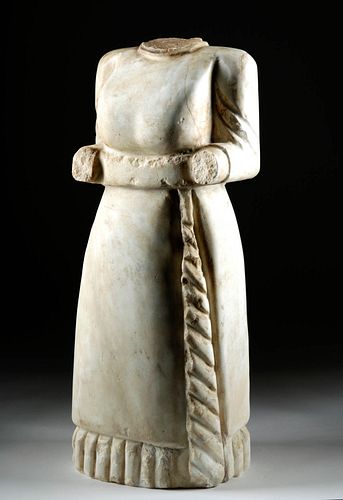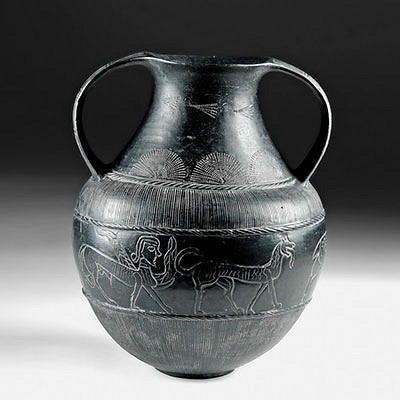Tall Roman Marble Statue - Married Woman
Lot 27
About Seller
Artemis Fine Arts
686 S Taylor Ave, Ste 106
Louisville, CO 80027
United States
Selling antiquities, ancient and ethnographic art online since 1993, Artemis Gallery specializes in Classical Antiquities (Egyptian, Greek, Roman, Near Eastern), Asian, Pre-Columbian, African / Tribal / Oceanographic art. Our extensive inventory includes pottery, stone, metal, wood, glass and textil...Read more
Estimate:
$13,000 - $19,500
Absentee vs Live bid
Two ways to bid:
- Leave a max absentee bid and the platform will bid on your behalf up to your maximum bid during the live auction.
- Bid live during the auction and your bids will be submitted real-time to the auctioneer.
Bid Increments
| Price | Bid Increment |
|---|---|
| $0 | $25 |
| $300 | $50 |
| $1,000 | $100 |
| $2,000 | $250 |
| $5,000 | $500 |
| $10,000 | $1,000 |
| $20,000 | $2,500 |
| $50,000 | $5,000 |
| $100,000 | $10,000 |
| $200,000 | $20,000 |
About Auction
By Artemis Fine Arts
Sep 17, 2020
Set Reminder
2020-09-17 10:00:00
2020-09-17 10:00:00
America/New_York
Bidsquare
Bidsquare : CLEARANCE - Ancient, Pre-Columbian, Ethno Art
https://www.bidsquare.com/auctions/artemis-gallery/clearance---ancient-pre-columbian-ethno-art-5605
End-of-Summer Clearance sale featuring discounted pricing on antiquities from Egypt, Greece, Italy, and the Near East...plus Viking, Asian, Pre-Columbian, Tribal, Russian Icons, Spanish Colonial, Fine Art, more! Starting prices have been reduced up to 65% from original auction prices. Artemis Fine Arts info@artemisgallery.com
End-of-Summer Clearance sale featuring discounted pricing on antiquities from Egypt, Greece, Italy, and the Near East...plus Viking, Asian, Pre-Columbian, Tribal, Russian Icons, Spanish Colonial, Fine Art, more! Starting prices have been reduced up to 65% from original auction prices. Artemis Fine Arts info@artemisgallery.com
- Lot Description
**Originally Listed At $7500**
Roman, Imperial Period, ca. 1st to 4th century CE. Carved from a large, solid piece of beautiful, creamy marble, this is a tomb attendant figure, depicting a woman's body dressed in a stola. The carving gives an exceptional view of a piece of clothing that is often hidden by a gauzy, draped himation in artwork, and also gives us important clues as to the identity of the woman depicted in the statue. The flounce on the long side of the skirt and the bottom, the high waist held in place by a thick belt, and the gathered sleeves are all nicely carved here. The rest of the marble surface is beautifully smooth. The hands probably once held items - a fan, maybe, or a mirror - while the head likely had a detailed and ornate coiffure. This figure probably graced a tomb, serving as an attendant and mourner. Size: 6" L x 9" W x 22" H (15.2 cm x 22.9 cm x 55.9 cm)
Stolae were made of linen or wool, although the wealthiest women could wear ones made of silk. They came in a variety of colors - reds, yellows, and blues - and often had decoration on the neckline and hem, like the flounce seen here. Roman women had to adhere to strict rules about clothing. A woman could only dress in the stola after her marriage (in fact, courtesans could only wear men's togas!), and they were an outward sign of the wealth and prestige associated in the Roman world with being a married woman.
Provenance: private East Coast, USA collection; ex-William Froelich collection, New York, USA, acquired in the 1970s
All items legal to buy/sell under U.S. Statute covering cultural patrimony Code 2600, CHAPTER 14, and are guaranteed to be as described or your money back.
A Certificate of Authenticity will accompany all winning bids.
We ship worldwide and handle all shipping in-house for your convenience.
#141481Head and hands are lost. Surface wear commensurate with age, with scratching and chips, especially around where the hands used to be and down the fringe of the garment. Nice deposits on surface and good preservation of remaining form.Condition
- Shipping Info
-
All shipping is handled in-house for your convenience. Your invoice from Artemis Gallery will include shipping calculation instructions. If in doubt, please inquire BEFORE bidding for estimated shipping costs for individual items.
-
- Buyer's Premium



 EUR
EUR CAD
CAD AUD
AUD GBP
GBP MXN
MXN HKD
HKD CNY
CNY MYR
MYR SEK
SEK SGD
SGD CHF
CHF THB
THB














